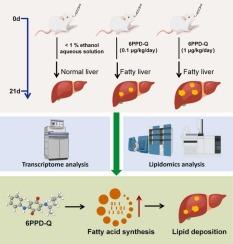低剂量轮胎磨损化学物质6PPD-Q暴露通过促进脂肪酸生物合成引起ICR小鼠脂肪肝
IF 11.3
1区 环境科学与生态学
Q1 ENGINEERING, ENVIRONMENTAL
引用次数: 0
摘要
N-(1,3-二甲基丁基)-N ' -苯基-对苯二胺-醌(6PPD- q)作为轮胎磨损化学物质6PPD的主要代谢物已被证明是人类暴露的新负担,通过饮用水、空气颗粒物和食物来源的污染。虽然越来越多的人关注它的副作用,但在实际剂量下,6PPD-Q对哺乳动物的潜在肝毒性尚不清楚。本研究通过转录组学和脂质组学分析相结合的综合方法,研究了环境相关剂量下6PPD-Q对成年小鼠肝脏的毒性作用及其潜在机制。我们发现6PPD-Q暴露在暴露三周后会导致过度的脂质沉积,最终导致脂肪肝的发病机制。机制上,6PPD-Q暴露导致小鼠肝组织内脂肪酸含量显著增加,通过促进其生物合成,从而促进脂质沉积。综上所述,本研究对6PPD-Q对肝脏脂质代谢的内分泌干扰作用及其如何导致脂肪肝疾病风险升高提供了新的认识。我们的研究结果呼吁公众关注6PPD-Q的风险评估,特别是慢性代谢性疾病的风险评估。本文章由计算机程序翻译,如有差异,请以英文原文为准。

Low-Dose Tire Wear Chemical 6PPD-Q Exposure Elicit Fatty Liver via Promoting Fatty Acid Biosynthesis in ICR Mice
N-(1,3-dimethylbutyl)-N’-phenyl-p-phenylenediamine-quinone (6PPD-Q) as a major metabolite of tire wear chemical 6PPD has been demonstrated to be an emerging burden of exposure in human populations, via contamination from drinking water, air particulate matter and food sources. Whilst increasing attention has been moved toward its adverse effect, the potential hepatotoxicity of 6PPD-Q in mammals at realistic dose remains unknown. Here, the toxic effects of 6PPD-Q at environmentally relevant dose on the liver of adult mice and its underlying mechanism were investigated through an integrative approach combining transcriptomic and lipidomic analyses. We found that 6PPD-Q exposure induced excessive lipid deposition following three weeks of exposure, ultimately contributing to the pathogenesis of fatty liver disease. Mechanistically, 6PPD-Q exposure caused a remarkable increase in the contents of fatty acids within the hepatic tissue of mice by enhancing their biosynthesis, thereby facilitating lipid deposition. In summary, this study provides a new understanding on the endocrine disrupting effects of 6PPD-Q on hepatic lipid metabolism and how it may contribute to elevated risk of fatty liver disease. Our findings call for a potential public health attention on the risk assessment of 6PPD-Q, particularly towards the risk of chronic metabolic diseases.
求助全文
通过发布文献求助,成功后即可免费获取论文全文。
去求助
来源期刊

Journal of Hazardous Materials
工程技术-工程:环境
CiteScore
25.40
自引率
5.90%
发文量
3059
审稿时长
58 days
期刊介绍:
The Journal of Hazardous Materials serves as a global platform for promoting cutting-edge research in the field of Environmental Science and Engineering. Our publication features a wide range of articles, including full-length research papers, review articles, and perspectives, with the aim of enhancing our understanding of the dangers and risks associated with various materials concerning public health and the environment. It is important to note that the term "environmental contaminants" refers specifically to substances that pose hazardous effects through contamination, while excluding those that do not have such impacts on the environment or human health. Moreover, we emphasize the distinction between wastes and hazardous materials in order to provide further clarity on the scope of the journal. We have a keen interest in exploring specific compounds and microbial agents that have adverse effects on the environment.
 求助内容:
求助内容: 应助结果提醒方式:
应助结果提醒方式:


